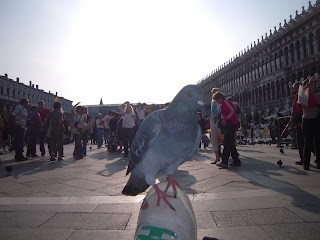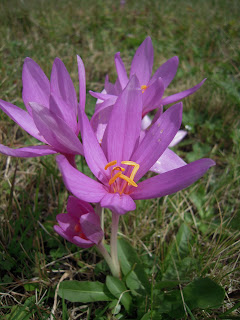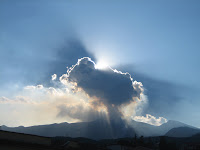 The Camino de Santiago is historically a religious pilgrimage to the resting site of Saint James, an apostle of Jesus. The Camino de Santiago translates to the way of St James and covers approximately 800km from the French/Spanish border to the city of Santiago de Compostela, about 90km inland from the western Spanish coastline on the Atlantic Sea. It is most commonly known by pilgrims simply as ‘the Way’.
The Camino de Santiago is historically a religious pilgrimage to the resting site of Saint James, an apostle of Jesus. The Camino de Santiago translates to the way of St James and covers approximately 800km from the French/Spanish border to the city of Santiago de Compostela, about 90km inland from the western Spanish coastline on the Atlantic Sea. It is most commonly known by pilgrims simply as ‘the Way’.No laptop, no mobile phone, no iPod to entertain, nothing but the most comfortable pair of shoes and two sets of the best light weight clothing I could find. We (a good mate and I) had chosen to do the way as ‘rough’, or as traditional as we could, depending on how you wanted to look at it. Assessing the feasibility of recharging electronics on the way, it almost made our minds up for us, and as a result the only electronic device we left with was a digital camera to capture some of the finest moments of the experience, and a few extra batteries as backup. That was the extent of our modern comforts, which are all too common in the backpackers of this millennium. I felt ‘old school’, often envying travellers of the 70s whose freedom to explore led them on the Hippy Trail travelling the expanse overland from Europe to Asia. Donning only the basic of necessities, of which comprised of Tiger Balm for aches and pains, a journal to jot down my thoughts and a water bottle, we started walking.
Head and face shaven to prevent the need for razors and shave cream (again cutting just milligrams off the weight I carried); I had taken years off my already youthful appearance. I was about three days fresher than the bread we were to eat that first night, which accompanied what was to become a popular meal for pilgrims - lentil soup. As we headed into the Pyrenees on our first day, the hike up was by no means easy, my mind was plagued by the discomfort and weight of my pack, and in many ways my preoccupation with such important things this early in the game ensured my success not only at the beginning, but also long term in reaching the end of the very long road.
Life on the way is simple. Wake up early, start walking, rest under a tree, stop at a café for a coffee and croissant, lunch under a different tree of cheese and ham with bread, then the next town you would pass through is often where you might make the decision to stop. You follow the signs or the trail of people to the local Rifugio where you sign in for the night, and receive your next stamp in you ‘Pilgrims Passport’. Having walked roughly 20-25km, you are weary, so a cold beer (Mahou or San Mig) is essential, then siesta, write in your journal, communal dinner with fellow pilgrims, sleep. Between nearly every one of those events, attention is made to your feet. They are your mode of transport and must be cared for. Bathing them in every cool running stream, massaging them, and tending to some savage blisters that have developed, ingrown toenails and other bizarre abnormalities becomes part of day to day routine. I love and appreciate my feet like you wouldn’t believe.
With each day, boredom didn’t invade me as I would have suspected, with the simpler life comes a simpler approach. I began to notice the smallest of flowers and insects on the roadside and hours could be spent pushing oneself in an attempt to catch the person who is as small as an ant on the distant horizon. Crops such as almonds, avocado, olives, beetroot, potatoes, beans and local specialties such as white asparagus and grape vines which stretched endlessly over the landscape contours, also added endless entertainment as the desire to eat fresh from the land prevailed.
Necessities appeared to be fewer each day, as an hour here and there visualising and assessing every piece of kit in my pack was yet another form of entertainment. Along with these various styles of self amusement, the time allowed for conscious thoughts to be trained. I had read about walking meditations and methods of focusing the mind prior to leaving Australia, and as a result I had prepared myself by taking with me some meditative phrases and prayers. I read these repeatedly on some of my loneliest of days, attempting to make sense of each word, and in turn seeking a higher level of self awareness. With each step I took, another revelation was conquered after hours of circular thought. With each revelation I made I was one step closer to my own apparent salvation, and even closer to the final destination – Santiago de Compostela in north western Spain.
Having passed through the rolling hills of Navara and Rioja in northern Spain, where good red wine is famous for maintaining good health along ‘the way’, we reached the Meseta. This second part of the Camino from Logrono to Leon, passes over a massive flat plateau with an elevation of around 800m above sea level. Each day is blistering hot, dry and dusty with vivid blue skies offset by the yellow browning wheat fields that stretch as far as the eye can see. The rich blue sky is reminiscent of the intensity one experiences in country Victoria, and as such I felt comfortingly at home. For many people this part of the walk is very difficult, with authors such as Shirley McLaine documenting her peculiar hallucinogenic experiences across these vast expanses. It was certainly a turning point in the Camino, where those limited by time (and the suffering ones) frequently spent a rest day or two on a bus, ridding their overall experience of what makes the Camino ever so special. It is a walk of contrast, and to appreciate the best bits, the microcosms of purity in both landscape and the people you meet, you must walk the Meseta.
Lips cracked, the hot baking sun beaming down on my sun brown skin, the sticky tar of the molten road began to wear the soles of my shoes down quicker than one would have expected. Respite on the Meseta was few and far between, with the small amount of shade provided by large hay bales or a lone tree on the roadside and the opportunity to break, openly welcomed. Being the peak of summer, many streams had run dry and the opportunity to wade ones feet in cool running water was uncommon. In coming across irrigation channels, we stripped our sore sweat wrinkled feet from our smelly boots and socks to let the current of the water take their weight. The feeling of weightlessness was euphoric, no longer did it feel like the sun and the earth’s gravity was trying to push you into the dusty white gravel of the pilgrim’s path. The toll not only on the body but the mind begins to kick in as you begin to question your own sanity; or insanity depending on your perspective.
I began to wonder if I am actually getting any closer as the road to my right is not changing, the path I am walking on doesn’t change colour and the thousands of London Plane trees (I tried counting…) which have been strategically planted every 15m to provide shade for the pilgrims are young, and all look the same, sending me in and out of shade every seven or so steps. The angle of the sun cast a shadow in front of me in the mornings as I walked westward to the end of the world. Some days the sun appeared to change angle, sending me seemingly in the wrong direction, as the path and the shells which are representative of the Camino, reassuringly guided me on my way.
Sitting down on a baking concrete stoop out the front of a square concrete house, I worked on my walking stick, cutting the bark from the cambium, carefully shaping an elaborate pattern into my very own staff. For the five days following, the ceremonial staff carving sessions with the mate I was travelling with went on, we cared for our staffs as much as we cared for one another. They were our new best friends, something to entertain us and something that made us happy with each step made with them in our palm. They were a symbol of our own fragile states - they were everything that I was no longer; sturdy, strong and it served a functional purpose. I was lost, taken over by the journey and confused as to my purpose for walking the Camino, so distracted by my own thoughts I was, that I left my best friend (the staff, and the other one) behind...
Having met up and broken off more than once with numerous other pilgrims, hearing the phrase ‘’Beun Camino!’’ come from the lips of a fellow peregrine was always reassuring. We were all in this journey together, albeit walking for different reasons. The companionship and kindness that is evident along the way is reminiscent of what the Camino is all about, and it is this which drove me on my way to reach Santiago de Compostela. On arrival to the big city, it was somewhat overwhelming, and yet again the experience of reaching the final desitination is different for everyone. Many pilgrims commonly feel an anticlimax of reaching the end after many long weeks of walking. This anticlimactic feeling leads them to ask ‘what next?’, and the answer to this was to often keep walking until they reached the Atlantic sea, some 100km further. I myself was done, my Camino was finished and I was happy to stop walking. I had set myself a personal challenge of reaching Santiago de Compostela, and I had reached that. I was no longer a lost withering soul, and had many things to look forward to. I went to have one of the best years of my life so far.
The Camino, is a special and life altering experience while in some ways it might be said to be a very selfish exercise. You will invariably meet up with similar people each day, but you should never expect to see them in the morning. Some days, they would just disappear for whatever reason. Every pilgrim had their own story, and this is not something that was as openly discussed as I would have imagined. Having said this, I can understand why this was so. We were all battling our own demons within, but knew that the pilgrim both in front and behind you, albeit a stranger, was a friend. There is unspoken compassion and empathy on the way which is uncompromisingly forgiving. Yes, we all had days of selfishness, but all in all, this one long difficult experience was a pinnacle moment, a turning point in our lives which would shape our future. For this reason, ‘holiday pilgrims’ (those that joined up for the last 200km just to receive a Compostela; the certificate) were often frowned upon by the ‘purists’ and those that had walked many weeks and hundreds of kilometres from the Pyrenees, or even further...
I guess to sum up the experience; the Camino is a testament to your state of mind and body. You might believe that you are one of the most together people that you know, but this is one of life’s challenges which will invariably test your limits. You will have defining moments that may, at the time, seem small and trivial, but which will surely shape your future synaptic thoughts. Am I enlightened by my attempts at walking meditation and prayer? I do not know, there is no simple answer. I believe in many things in this world, but I do know is that this one experience, taking the conscience time to self-assess and challenge my mental and physical self is just one step closer to understanding who I am, and what I can do to ensure I am a contributing person to a positively productive society.
Written by Anthony J Curnow
Note: It has taken me a year to reach the point where I can sit down with some perspective and write this article. The Camino is a phenomenal experience.















































































